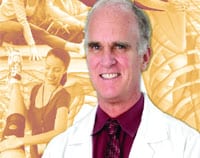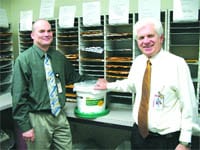Loose and Limber Stretching Is a Key Component of an Exercise Regimen
Despite all the talk of an obesity epidemic and kids who spend too much time indoors, Americans are generally well-aware of the benefits of exercise, said Dr. Michael Craig.
“The good news is that people of all ages are exercising and working out,” said Craig, an orthopedic surgeon at Mercy Medical Center. He added, however, that stretching — the manner in which someone warms up before physical activity and cools down afterward — can have an impact not only on the effectiveness of the workout, but on risk of injury.
“The importance of stretching really exists for every age group,” he explained. “In the young, growing athlete, it’s important to stretch to maintain the flexibility of the joint so they don’t get injured. A young person can have tight hamstrings and a tight heel cord, so it’s good to be mobilized before they go out and compete.”
Fortunately, he said, young people tend to be the best-educated age group when it comes to stretching because youth sports coaches are so well-versed in its importance.
“They make sure young athletes stretch,” Craig said. “Some early teens may feel it’s not cool to stretch, but when the coach insists, it happens. All it takes it one pulled muscle or a pulled ligament or tendon to keep them off the field for a few months.”
For middle-aged athletes, the issue isn’t what’s cool, but what’s fast. And seeing stretching as an unnecessary demand on one’s time can lead to trouble, Craig said.
“People have demands — jobs, families — and sometimes when they get to the gym to work out, they don’t feel stretching is an important part of their workout. They have limited time, so they don’t want to go to the mat and stretch; they want to get on the machine or start lifting weights.”
The problem, he said, is that many people, outside of their set exercise routines, work sitting down or otherwise have sedentary lifestyles. “They’re not moving around very much, and as people get older, they lose muscle mass. Not stretching before exercise is a good way to pull a muscle.”
People approaching the retirement years are at even greater risk of injury, he said. But although exercise-related injuries related to tight muscles aren’t necessarily more severe in old people, the recovery time is often much longer than it is for a teenager.
“Athletes don’t heal as well at 40 than they do at 12. It takes longer to get it back,” Craig explained. “The natural aging process means we lose muscle mass as the years go by, and if an injury sidelines you, it can be tougher to get back to your pre-injury status than when you were 12 or 14.”
Getting Warmer
The American Academy of Orthopedic Surgeons touts stretching as not just an activity performed before and after a workout, but an essential part of that workout.
“An effective fitness program is more than aerobic training and strength building,” the AAOS asserts. “To really reap the benefits of exercise, you need to add flexibility training to the mix.”
Simply put, the academy notes, the more flexible someone is, the less likely they are to be injured during exercise. A good warmup prepares the body for more intense activity, gets the blood flowing, raises muscle temperature, and increases breathing rate — all of which gives the body time to adjust to the demands of exercise and even improves performance.
Just as a warmup prepares the body for exercise, an effective cooldown period gives the body time to recover, the academy notes. A cooldown begins by gradually decreasing the intensity level at the end of an exercise session.
“For example,” the AAOS suggests, “if you have been walking at a quick pace, begin cooling down by slowing your steps and taking your arms out of the movement. Walk at a comfortable pace until your breathing and heart rate have returned to normal. Once you are breathing easily, stretch while your muscles are still warm.”
Specific types of stretches applicable to various situations may be found on the academy’s Web site, www.aaos.org. In addition, the Mayo Clinic offers the following advice to achieve proper stretching.
- Target major muscle groups. When stretching, focus on the calves, thighs, hips, lower back, neck, and shoulders. Also stretch muscles and joints routinely used at work or play.
- Warm up first. Injury can result from stretching cold muscles. A pre-stretch warmup may include walking while gently pumping the arms, or doing a favorite exercise at low intensity for five to 10 minutes. Stretching after exercise, when the muscles are warm and more receptive to stretching, is also key.
- Pace yourself. It takes time to lengthen tissues safely. Each stretch should be held for about 30 seconds, then repeated on the other side. The process may be repeated three or four times.
- Don’t bounce. Bouncing while stretching can cause small tears in the muscle. These tears leave scar tissue as the muscle heals, which tightens the muscle even further — making the athlete less flexible and more prone to pain.
- Focus on a pain-free stretch. Feeling tension while stretching is normal. But if it hurts, the activity has gone too far. The athlete should back off to the point where there is no pain, then hold the stretch.
- Relax and breathe freely. It’s not helpful to hold one’s breath while stretching.
- Know when to exercise caution. It’s not just about a formal workout routine; stretching can be done anytime and anywhere — in the home, at work, or while traveling. However, someone with a chronic condition or an injury may need to alter his or her approach to stretching. For example, stretching a strained muscle may cause further harm. A doctor or physical therapist can advise an individual on the best way to stretch.
Outside the Box
Some exercise trends promote stretching as an intrinsic part of the workout, Craig said, noting the rising popularity of yoga and even a high-impact variation known as ‘extreme yoga.’
“Yoga has become extremely popular and has been very helpful for older or middle-aged athletes,” he said. “It’s basically a form of exercise, but it’s also maintaining and stretching the joints and muscles. And that’s a good thing.”
After all, why shouldn’t the definition of exercise be flexible, too?




Comments are closed.